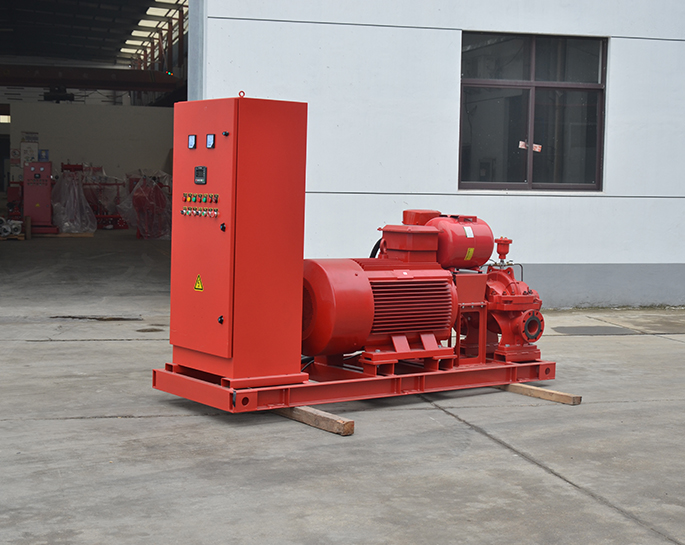What are the considerations for selecting the appropriate fire pump controller for an electric fire pump system?
Apr 02, 2024
Share:
Selecting the appropriate fire pump controller for an electric fire pump system involves several important considerations to ensure reliable and efficient operation in emergency situations. Here are key factors to consider:
1. **Compliance**: Ensure the fire pump controller complies with relevant standards and codes, such as the National Fire Protection Association (NFPA) standards, local building codes, and regulatory requirements. Compliance ensures that the controller meets minimum safety and performance standards.
2. **System Capacity**: Determine the required flow rate and pressure for the fire protection system based on factors such as building size, occupancy type, fire hazard level, and applicable codes. Select a controller capable of meeting or exceeding the system's capacity requirements.
3. **Type of Control**: Choose between manual, electric, or diesel-driven fire pump controllers based on factors such as available power sources, reliability requirements, and system complexity. Electric fire pump controllers are common for buildings with reliable electrical power sources.
4. **Redundancy and Reliability**: Consider redundancy features to ensure system reliability in case of controller failure or maintenance. Dual-redundant controllers or backup power sources can provide additional reliability for critical fire protection systems.
5. **Remote Monitoring and Control**: Select a controller with remote monitoring and control capabilities to enable real-time monitoring of pump status, alarms, and system performance from a central location. Remote access facilitates proactive maintenance and troubleshooting.
6. **Integration with Building Management Systems**: Ensure compatibility and integration with building management systems (BMS) or fire alarm systems for seamless operation and centralized control. The controller should support communication protocols commonly used in building automation systems.
7. **User Interface**: Choose a controller with an intuitive user interface that simplifies operation, configuration, and monitoring. Clear status indicators, alarms, and diagnostic information help operators quickly identify issues and take appropriate actions.
8. **Alarm and Notification Features**: Verify that the controller provides robust alarm and notification features to alert operators of pump failures, system faults, or abnormal conditions. Audible and visual alarms, as well as remote notification capabilities, are essential for timely response to emergencies.
9. **Enclosure and Environmental Protection**: Ensure the controller is housed in a suitable enclosure that provides protection against environmental factors such as moisture, dust, temperature extremes, and physical damage. Enclosures should meet relevant NEMA or IP ratings for outdoor or indoor installations.
10. **Manufacturer Support and Service**: Choose a controller from a reputable manufacturer with a history of providing reliable products, technical support, and responsive service. Consider factors such as warranty coverage, availability of spare parts, and manufacturer's track record in the industry.
By considering these factors, you can select the appropriate fire pump controller that meets the specific requirements of your electric fire pump system, ensuring reliable and effective fire protection for the building or facility. Consulting with fire protection engineers, electrical contractors, and system integrators can provide valuable expertise in the selection process.

1. **Compliance**: Ensure the fire pump controller complies with relevant standards and codes, such as the National Fire Protection Association (NFPA) standards, local building codes, and regulatory requirements. Compliance ensures that the controller meets minimum safety and performance standards.
2. **System Capacity**: Determine the required flow rate and pressure for the fire protection system based on factors such as building size, occupancy type, fire hazard level, and applicable codes. Select a controller capable of meeting or exceeding the system's capacity requirements.
3. **Type of Control**: Choose between manual, electric, or diesel-driven fire pump controllers based on factors such as available power sources, reliability requirements, and system complexity. Electric fire pump controllers are common for buildings with reliable electrical power sources.
4. **Redundancy and Reliability**: Consider redundancy features to ensure system reliability in case of controller failure or maintenance. Dual-redundant controllers or backup power sources can provide additional reliability for critical fire protection systems.
5. **Remote Monitoring and Control**: Select a controller with remote monitoring and control capabilities to enable real-time monitoring of pump status, alarms, and system performance from a central location. Remote access facilitates proactive maintenance and troubleshooting.
6. **Integration with Building Management Systems**: Ensure compatibility and integration with building management systems (BMS) or fire alarm systems for seamless operation and centralized control. The controller should support communication protocols commonly used in building automation systems.
7. **User Interface**: Choose a controller with an intuitive user interface that simplifies operation, configuration, and monitoring. Clear status indicators, alarms, and diagnostic information help operators quickly identify issues and take appropriate actions.
8. **Alarm and Notification Features**: Verify that the controller provides robust alarm and notification features to alert operators of pump failures, system faults, or abnormal conditions. Audible and visual alarms, as well as remote notification capabilities, are essential for timely response to emergencies.
9. **Enclosure and Environmental Protection**: Ensure the controller is housed in a suitable enclosure that provides protection against environmental factors such as moisture, dust, temperature extremes, and physical damage. Enclosures should meet relevant NEMA or IP ratings for outdoor or indoor installations.
10. **Manufacturer Support and Service**: Choose a controller from a reputable manufacturer with a history of providing reliable products, technical support, and responsive service. Consider factors such as warranty coverage, availability of spare parts, and manufacturer's track record in the industry.
By considering these factors, you can select the appropriate fire pump controller that meets the specific requirements of your electric fire pump system, ensuring reliable and effective fire protection for the building or facility. Consulting with fire protection engineers, electrical contractors, and system integrators can provide valuable expertise in the selection process.







